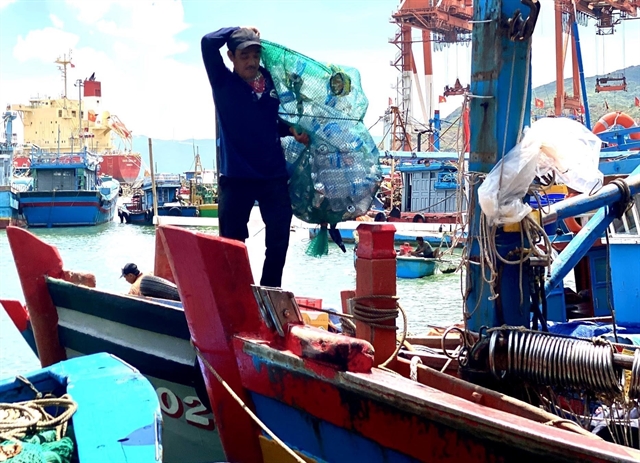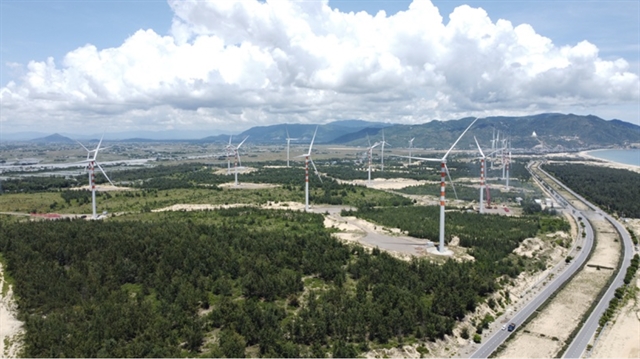 Environment
Environment

 |
| Phương Mai Wind Power Plant at the Nhơn Hội Economic Zone in Quy Nhơn City, Bình Định Province. Photo baodautu.vn |
BÌNH ĐỊNH – The central coastal province of Bình Định is an area frequently affected by natural disasters such as storms, heavy rainfall and floods, landslides and droughts.
Climate change exacerbates the intensity of these phenomena, significantly impacting socio-economic development and posing risks to biodiversity.
According to Nguyễn Tuấn Thanh, Vice Chairman of the Bình Định People's Committee, the province has completed four projects related to climate change with a total investment of over VNĐ912 billion (US$35.7 million), including construction of climate-resilient infrastructure for ethnic minorities, greenhouse gas inventory, emission management solutions, building flood resilience for communities and monitoring climate change using remote sensing technology.
For reducing greenhouse gas emissions, the provincial Department of Natural Resources and Environment (DoNRE) has coordinated with relevant agencies to review and update the list of greenhouse gas-emitting establishments in order to conduct greenhouse gas inventories within their managed areas and verify the inventory results according to sector management.
As for a pilot project introducing electric four-wheel vehicles for tourists in parts of Quy Nhơn City and nearby tourist spots, three transport companies have been participating, with a total of 95 electric vehicles.
The province also has nine solar and wind power projects under construction, of which four solar power projects are currently operational and one has completed phase one. All of the solar projects together have a total capacity of 529.5MWp. Meanwhile four wind power projects will have a total capacity of 107.4MWp. The province also has about 2,092 rooftop solar power systems with a total capacity of 228MWp.
Forestry protection and development
For the last year, Bình Định has made forestry protection and development a priority.
Most of the bare land and barren hills have been reforested, contributing to disaster mitigation, climate change adaptation and environmental stability. The quality and area of forests have been considerably improved year by year, providing environmental benefits and creating raw material areas for the processing industry, as well as increasing income for local residents.
To date, Bình Định has planned agricultural, forestry and fisheries production areas that suffer climate change impacts, adjusted crop structure and seasons to adapt with climate change, and researched to ensure livelihoods for people in the areas severely affected by climate change, such as regions frequently hit by flash floods and landslides.
Simultaneously, climate change mitigation and disaster prevention have been integrated into the province's planning for 2021-2030, the district-level land use planning for 2021-2030 and plans for urban construction and rural development.
The province has protected a 134km coastal corridor that was marked with boundary markers. It has also conducted surveys and identified landslide-prone areas, relocated residents from hazardous zones, developed a programme for protecting and restoring upstream forests, restructured the agriculture sector to adapt to climate change and created communication plans to adapt to climate change while integrating socio-economic solutions.
Thanh said: “The local agencies increasingly focus on implementing policies and laws relating to climate change preparedness and responses.”
“Climate change response and disaster mitigation activities have been accelerated, suitable for provincial conditions in the context of national and global climate change impacts,” Thanh told tainguyenmoitruong.vn.
“The effectiveness of climate change programmes and projects, including infrastructure projects, has been enhanced boosting the effectiveness of climate change response capacity, including saltwater intrusion prevention,” he said.
“Furthermore, the establishment and operation of green energy projects and the use of environmentally friendly energy have contributed to ensuring energy security, mitigating climate change, protecting the environment and promoting sustainable socio-economic development in the province,” the vice chairman said.
In the future, Bình Định will continue integrating its climate change response into strategies, plans and socio-economic development plans, such as drought and saline water intrusion prevention, storm and flood responses, through provincial-level scientific and technological tasks, construction activities and forest protection and development.
Efforts will focus on reducing greenhouse gas emissions, substances depleting the ozone layer, developing renewable energy and recovering energy from waste.
The province will promote the development and application of climate change response technologies, restructure the agriculture sector for biological safety in line with climate change and reduce greenhouse gas emissions.
Building a climate change monitoring database, developing climate change response scenarios and using remote sensing technology in monitoring climate change will be prioritised, he added. VNS




